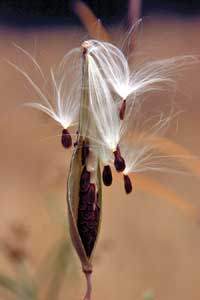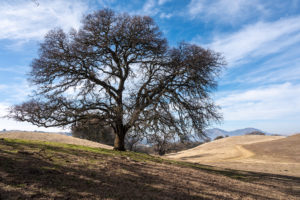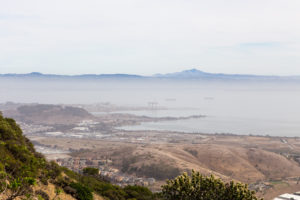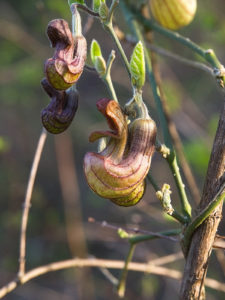The old adage says the apple doesn’t fall far from the tree, but that’s really just the beginning of the story from the tree’s point of view. The real excitement starts when animals&mdashbirds, deer, people—come along and carry the apples away, perhaps spitting out the seeds as they eat. For the tree, that’s the whole point of the apple.
- Milkweed
California’s native plants are no different. Although some plants benefit by simply dropping their seeds close to their own “feet” (where conditions are sure to be right, since the parent plant grew well enough to go to seed), others produce the most offspring when their seeds spread as far as possible. If seedlings of these plants sprout close to their parents, they will be forced to compete with them for soil, sunlight, water, and nutrients.
So plants have evolved many ways to spread their seeds far and wide. The interplay of dispersal methods determines a plant’s seed shadow, the footprint within which a plant’s seeds are distributed around the parent plant.
Sedges found along Bay Area streams drop their seeds in the water, which carries the seeds—and the plant’s seed shadow—downstream until the seeds lodge in a place where they can sprout and grow. Acorns from oak trees are collected each year by jays and squirrels. An oak’s seed shadow extends as far as a burdened jay can fly or a squirrel can bound before stashing its cache; some of those buried acorns will be forgotten and later sprout.
The seeds of plants such as mountain mahogany and milkweed come equipped with structures to help them glide long distances rather than plummeting to earth. The mountain mahogany seed has a long, twisty feather that helps it catch the wind, while a milkweed seed has large silky hairs that keep it aloft longer, like a parachute. Such seeds’ shadows are as wide as the wind can carry them.
California’s state grass, purple needlegrass, broadcasts its seeds short distances by wind before they come to rest on the ground. There, the seeds’ long “tails” take over, coiling as they dry and drilling the seeds into the ground. The wind-dispersed mountain mahogany seed buries itself in the soil in a similar manner.
Some mistletoe seeds blast out of their ripe berries with an audible “pop” in a sticky goo that can adhere to plants, animals, and nearby surfaces. This strategy helps transport the parasitic plant to new hosts. Mistletoes also rely on birds either to carry their berries to other branches and trees before wiping the goo-bound seeds off their beaks and onto a vacant limb, or, more commonly, to eat the seeds and pass them out the other end, complete with a dollop of fertilizer.
With a bit of luck, a well-placed seed will become one of many sprouts to grow and someday cast their own looming seed shadows.
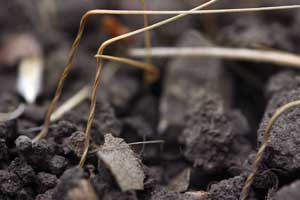
- Purple needlegrass
Get out!
Get ready to set seed! The San Francisco Botanical Garden offers a summer family adventure drop-in program for preschoolers and their parents on Mondays and Fridays. Activities include guided walks, garden crafts, storytelling, and singing. Activities are flexible, and families can explore at their own pace [$3 per family; (415)661-1316, ext. 307, San Francisco Botanical Garden].
Up in Sebastopol, the Earth Roots Collective is offering a series of weeklong day camps, through August 24, featuring hands-on gardening classes and sustainable craft projects <[a href=http://www.earthrootscollective.org target=_blank>Earth Roots Collective, (707)332-8906]. The University of California Botanical Garden‘s weeklong Green Stuff Day Camp introduces children to plants of the world, plant crafts, and home gardening. Kids can also sample food grown in the Crops of the World garden <[a href=http://www.botanicalgarden.berkeley.edu target=_blank>University of California Botanical Garden, (510)643-2755].
Throughout the year, the Carquinez Regional Environmental Education Center‘s CREEC Youth program, based in Martinez, focuses on basic native plant propagation through collecting seed, taking plant cuttings, and going on educational hikes in the area [alternating Friday afternoons and Saturday mornings; Carquinez Regional Environmental Education Center, (925)818-4460].
Anyone over ten years old can learn all about native plant reproduction every Wednesday and Saturday at the Presidio Native Plant Nursery. Volunteers collect seeds, plant and tend seedlings, weed, monitor restoration sites, and keep the nursery in order [9 a.m. – 12 p.m./1 p.m. – 4 p.m.; no fee; no RSVP; (415)561-4830].
The Regional Parks Botanic Garden in Berkeley’s Tilden Park, where two of the photos at left were taken, is a treasure trove of California natives, many setting seed right now. The garden offers docent-led tours for all ages every Saturday and Sunday at 2 p.m. <[a href=http://www.nativeplants.org target=_blank>Friends of the Regional Parks Botanic Garden, (510)841-8732].

.jpg)
